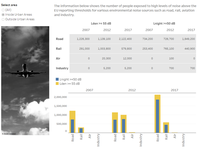
These country profiles summarise information on noise pollution for each of the EEA-33 member countries. The profiles are based on the latest official noise data reported every five years by EEA member countries under the Environmental Noise Directive (END).

These country fact sheets summarise information on noise pollution for selected EEA member countries. The fact sheets are based on the latest official noise data reported every five years by EEA member countries under the Environmental Noise Directive (END).

These country fact sheets summarise information on noise pollution for selected EEA member countries. The fact sheets are based on the latest official noise data reported every five years by EEA member countries under the Environmental Noise Directive (END).

These country fact sheets summarise information on noise pollution for selected EEA member countries. The fact sheets are based on the latest official noise data reported every five years by EEA member countries under the Environmental Noise Directive (END).

These country fact sheets summarise information on noise pollution for selected EEA member countries. The fact sheets are based on the latest official noise data reported every five years by EEA member countries under the Environmental Noise Directive (END).

These country fact sheets summarise information on noise pollution for selected EEA member countries. The fact sheets are based on the latest official noise data reported every five years by EEA member countries under the Environmental Noise Directive (END).

These country fact sheets summarise information on noise pollution for selected EEA member countries. The fact sheets are based on the latest official noise data reported every five years by EEA member countries under the Environmental Noise Directive (END).

These country fact sheets summarise information on noise pollution for selected EEA member countries. The fact sheets are based on the latest official noise data reported every five years by EEA member countries under the Environmental Noise Directive (END).

These country fact sheets summarise information on noise pollution for selected EEA member countries. The fact sheets are based on the latest official noise data reported every five years by EEA member countries under the Environmental Noise Directive (END).

These country fact sheets summarise information on noise pollution for each of the EEA-33 member countries. The fact sheets are based on the latest official noise data reported every five years by EEA member countries under the Environmental Noise Directive (END).

These country fact sheets summarise information on noise pollution for selected EEA member countries. The fact sheets are based on the latest official noise data reported every five years by EEA member countries under the Environmental Noise Directive (END).

These country fact sheets summarise information on noise pollution for selected EEA member countries. The fact sheets are based on the latest official noise data reported every five years by EEA member countries under the Environmental Noise Directive (END).

These country fact sheets summarise information on noise pollution for selected EEA member countries. The fact sheets are based on the latest official noise data reported every five years by EEA member countries under the Environmental Noise Directive (END).

These country fact sheets summarise information on noise pollution for selected EEA member countries. The fact sheets are based on the latest official noise data reported every five years by EEA member countries under the Environmental Noise Directive (END).

These country fact sheets summarise information on noise pollution for selected EEA member countries. The fact sheets are based on the latest official noise data reported every five years by EEA member countries under the Environmental Noise Directive (END).

These country fact sheets summarise information on noise pollution for selected EEA member countries. The fact sheets are based on the latest official noise data reported every five years by EEA member countries under the Environmental Noise Directive (END).

These country fact sheets summarise information on noise pollution for selected EEA member countries. The fact sheets are based on the latest official noise data reported every five years by EEA member countries under the Environmental Noise Directive (END).

These country fact sheets summarise information on noise pollution for selected EEA member countries. The fact sheets are based on the latest official noise data reported every five years by EEA member countries under the Environmental Noise Directive (END).

These country fact sheets summarise information on noise pollution for selected EEA member countries. The fact sheets are based on the latest official noise data reported every five years by EEA member countries under the Environmental Noise Directive (END).

These country fact sheets summarise information on noise pollution for selected EEA member countries. The fact sheets are based on the latest official noise data reported every five years by EEA member countries under the Environmental Noise Directive (END).